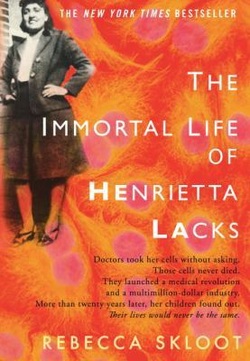
Release Date: Reprint edition (March 8, 2011)
Format: Kindle
Pages: 400
Source: Download Destination
Review Date: February 18, 2012
Rating: 3 bookmarks
This is black history month, and I was thinking about reading a classic by an African American author. That changed when I realized I had to read the this for one of the book clubs that I’m in. This story counts as black history, so check! Honestly, at first I didn’t want to read this book and I wasn’t looking forward to it. I thought the book would be to dry to read so, I sucked it up and rented the book on audio tape. This was an incredible story. Almost unbelievable. I apologize in advance if this review seems more like a book report rather than a literary review. Unfortunately, that is how this is one is going to go. This book tells the story of Henrietta, her family and the history of HeLa cells. Throughout the book, while Henrietta’s story being told, we get moments in the present with the author reflecting back on situations with various Lacks family members. We also hear about her experiences and the process she went through to learn all of this information for the book.
Most of this book is a mix of biology and history lessons rolled into one. In addition to the technical stuff, we find out about how John Hopkins took Henrietta’s cells without permission, harvested them, and sold them. We learn about Henrietta’s children and what happens to them as they grew up and even later in live as middle aged adults and beyond. We discover how they learned about their mothers cells and how it was virtually hidden from them. John Hopkins then hid Henrietta’s true identity on purpose when the public got a hold of the story on the immortal cells, most likely so they wouldn’t be caught. We also learn of Henrietta’s horrible struggle with cancer. She initially had cervical cancer, which they took her samples while she was under anesthesia being treated with Radium rods. I can’t imagine living in that time, being treated by a doctor sounds so horrible and barbaric. According to the doctors, the treatment worked and her cervical cancer was gone…to ensure it stayed gone, they began treating her with radiation, which I personally believe made the cancer come back with a vengeance. Within a few months of being “cured”, she had tumors all throughout her body. She died in the most terrible pain, unimaginable pain.
As chapter 17 rolls around, we learn about a cancer researcher, Southam, that injected HeLa into about a dozen a cancer patients. Shortly, those patients starting growing cancer nodules on their arms where HeLa was injected. After few months, the nodules vanished and/or removed, yet in some patients they later reappeared over and over again. In one patient HeLa cancer cells spread even more. He told them he was testing their immune system, he never said he was injecting them with someone else’s malignant cells. Shortly after the researcher began using volunteer prison inmates for his test. Tumors grew on their arms, same as the cancer patients. He also started injections into every gynecological surgery patient...without telling them the cells were cancerous! What a douche bag! He told them he was testing them for cancer. Followed by a lot of information on some history of the Nurumburg code, research ethics and conformed consent. Also describing how hard it was to prosecute researchers back in the 50’s. Eventually these actions got out to the press and suddenly doctors involved resigned. In 63’, his study was compared to Nazi research. The 3 doctors that resigned whom had helped Southam gave affidavits stating the experiments were immoral, illegal and much worse. In the end, he was on probation for 1 year. This incident opened the door for the strict research laws and requirements that we have today. For the next several chapters we learn about contaminated HeLa cells, the creation of nonprofit cell banks, HeLa hybrid cells, and more history lessons on the progress of cell research and how HeLa played a part in it.
As we read on, we got to hear horror stories about John Hopkins and other hospitals being known for snatching black people for experiments…totally horrible stories.
It was sad that Henrietta’s family didn’t know or initially understand what part of her was still alive. Nor did they really didn’t know what Henrietta’s cells where used for. Henrietta’s adult children gave blood to researchers in the 70’s and weren’t clear on what they were giving blood for. They thought the test was to see if they had the same cancer that killed their mother. It’s truly sad how uninformed they were at the time that they found out that the cells existed.
Beyond all of that that we learn of crazy lawsuits, horrible treatment of people under medical care, especially epileptic patients including elder daughter Elsie, in Crownsville hospital for the mentally ill. When we get to chapter 36 we even get a small dose of a religious explanation for Henrietta’s immoral cells. We learn that in at the end of learning all that Rebecca and Deborah could about Henrietta, right before the book was released, she died of a heart attack.
It’s crazy to think that even today, if you have a procedure, your cells could be used for research, without your knowledge. Not only this, but the ongoing debate as to if we even have a right to decide to allow our cells to be used. This topic is so complex, many arguments could be made for both sides on the matter.
No doubt, this is an interesting book. I was really amazed by all that I learned in this book. I had never heard of HeLa cells before, nor Henrietta Lacks. That’s probably because I’m not into biology…yet, HeLa cells were and still are a huge part of our advancement in medicine. We should all know what Henrietta’s cells did for us. If you’re up for learning something on the topic of cell research, check this book out.
Thankfully I found this nifty little timeline on Rebecca Skloot’s site. It was helpful in recalling all of the details. http://rebeccaskloot.com/wp-content/uploads/2011/03/HenriettaLacks_RGG_timeline.pdf
























